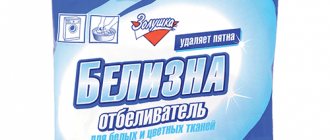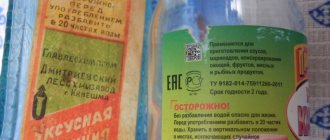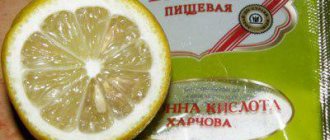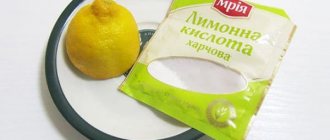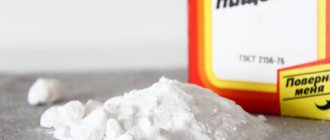At home, adding water from vinegar essence produces vinegar of varying concentrations, which is later used in cooking, canning, everyday life and folk medicine. To obtain 9% vinegar from 70% vinegar essence, certain numerical measures are calculated using tables, formulas and proportions. At the same time, when working with a concentrated substance, it is important to take precautions.
A substance such as pure acetic acid or its 70–80% solution (essence) is rarely used in everyday life in its pure form. High concentrations are quite caustic and may be hazardous to health. For household purposes, 3–15% vinegar is used, and most often it is necessary to dilute acetic acid 70% to 9%.
How is acetic acid obtained?
One of the most common industrial methods for producing acetic acid is the oxidation of acetaldehyde with atmospheric oxygen. The process is performed in the presence of a special catalyst - manganese acetate at a temperature of 50 to 60 ° C.
2CH3CHO + O2 → 2 CH3COOH
Previously, other methods for producing acetic acid were used, such as the oxidation of butane and acetaldehyde. Oxidation of acetaldehyde occurred in the presence of manganese at elevated pressure and temperature. The output could be 95% acetic acid.
But still, a natural acid is one that is obtained by fermentation. It can be grape or apple wine.
The properties of this substance may vary depending on the percentage of water in it. Because of this, for many centuries chemists believed that the acid from acetates and the acid from wine were two different substances. Naturally, this opinion was wrong. It all depends on the concentration of water.
Properties
Vinegar has, to put it mildly, a lot of properties, and if used correctly, we can consider and receive only positive qualities. But along with a large number of abilities, the varieties of liquid also grow. There are two main differences: one is natural (made by fermenting berry or fruit nectars), the second is synthetic (it is obtained by distilling petroleum raw materials, wood and gas).
Few people have thought about the beneficial qualities of 3 percent vinegar in general. It turns out that the solution contains an impressive amount of various elements in the form of iron, phosphorus and fluorine. It also has a large amount of vitamins (PP, A, K, E, B, C) and organic acids: propionic, tartaric or citric.
The nutritional value of the liquid shows small indicators. There are no proteins or fats per 100 g of product, but 2.3 g of carbohydrates. The calorie content of 3% vinegar is 11 kcal.
Apple cider vinegar 3% has proven to be a beneficial ingredient and source of potassium. Potassium facilitates connecting processes with more important microelements such as chlorine, calcium, silicon, sodium, magnesium and others. With regular and reasonable use, the solution is considered a very useful and necessary product.
Types of acetic acid.
96-100% is glacial (anhydrous) acetic acid, which is a colorless hygroscopic liquid or colorless crystals with a very unpleasant and pungent odor. Glacial acetic acid is used to carry out the synthesis of various dyes, as well as to accelerate the production of acetone and cellulose acetate. Glacial acid can also be used in the food industry, but only in the form of acetic essence or vinegar. It should be noted that in everyday life it can be used for cooking. This is due to the fact that it can be easily diluted with water if you know the correct proportions.
Glacial acetic acid is obtained by synthesis or fermentation of several organic substances. Also, glacial acid is always contained in the products of dry distillation of certain types of wood.
A 70-80% solution of acetic acid is called vinegar essence. Acetic essence is the trade name for an aqueous solution of edible acetic acid, which is obtained by fermentation of acetic acid alcohol liquids. As a rule, vinegar essence is used in the preparation of marinades, table vinegar and food canning. There are times when a recipe calls for vinegar essence for a twist, but the kitchen only has regular table vinegar 9%, or vice versa. Most housewives do not know how to get out of this situation. Therefore, you should know that these fluids are interchangeable. The main thing is to know how to properly dilute acetic acid, namely in what proportions.
For example, from table vinegar you need to get a 70% solution of vinegar essence. In this case, you need to reduce the amount of water by as much as you plan to add a bite. The calculation formula is very simple:
1 tablespoon of vinegar essence = 8 tablespoons of 9% vinegar per 7 tablespoons of water; 1 tablespoon of vinegar essence = 12 tablespoons of vinegar 6% per 11 tablespoons of water; 1 tablespoon of vinegar essence = 21 tablespoons of 3% vinegar per 20 tablespoons of water.
It should be noted that vinegar essence is a rather toxic substance, poisoning with which is considered the most common of household intoxications. Thus, a lethal dose, in the absence of verified medical assistance, is 30-50 milliliters of 80% vinegar essence.
If someone drinks acetic acid in its pure form, he will suffer severe burns to the mucous membranes of the pharynx and oral cavity, and the stomach and esophagus will also be affected. The most common consequences of absorption of acetic acid include hemolysis, hemoglobinuria, acidosis, and blood clotting disorders.
Vinegar (3-15% aqueous solution of acetic acid) is a product with a certain content of acetic acid. Often this substance is obtained as a result of microbiological synthesis using acetic acid bacteria from special alcohol-containing raw materials. Table vinegar can also be obtained from glacial acetic acid or mowing essence; you just need to know how acetic acid is diluted.
It is a slightly colored or colorless transparent liquid with a sharp sour taste and a specific unpleasant aroma. Vinegar is divided into synthetic and natural. It is widely used in cooking.
Natural food vinegar is produced in the following assortment: Fruit and apple (from fruit raw materials). Alcohol (from ethyl alcohol for food production). Wine (from grapes and wine materials). Balsamic (from grapes and wine materials through long-term aging in barrels of various types of wood). Flavored alcohol with natural flavors (plant extracts, spices). Malt. Whey (from purified whey).
As for synthetic vinegar, for food purposes it is produced in its pure form and with the addition of various flavors (synthetic, identical to natural and natural). It should be noted that in some countries the production of vinegar for food purposes is prohibited (Bulgaria, USA and France).
Selecting a quality product
Each year, acetic acid production exceeds 5 million tons. As in other industrial areas, there are fakes and low-quality products that contain unnecessary additives or the percentage ratio of water and acid is violated. As a result, when diluted, the resulting composition will have the wrong concentration, which can be dangerous.
When buying vinegar, consider the following features:
- purity of color (the solution must be transparent);
- absence of flocculent impurities and sediment;
- the appearance of foam when shaking (it is important that there is foam, but it disappears quickly);
- notes on the label (the percentage of acid and the presence of additives that are not desirable in a quality product are indicated);
- transparent glass containers (acid gradually corrodes plastic containers).
Table vinegar can be natural and synthetic
For culinary, cosmetic, and medical purposes, it is better to use types made from plant bases (wine, apple, balsamic, malt). But there is little such vinegar on the market today, and its price is higher, so replacement with a synthesized product is allowed.
Find out how to properly descale a kettle with vinegar.
We dilute the vinegar essence correctly.
Vinegar is an indispensable tool in everyday life, namely in the kitchen. There is vinegar of varying concentrations, but most often housewives use 6% and 9% concentrations. Acetic essence is not used due to ignorance or inability to prepare a 3rd solution of acetic acid with 70% essence.
Today, on bottles with vinegar essence labels, manufacturers write that it needs to be diluted with water in a ratio of 1:20, but this is not entirely true. There are also bottles where there is no such inscription at all. Therefore, you need to know how to use vinegar essence to get a table bite of varying concentrations.
To dilute the essence, you need to take cold water, filtered or boiled. A conventional unit (1 part) can be considered 1 tablespoon. The calculation on the vinegar calculator will show the inverse ratio of vinegar essence to table vinegar.
To prepare 3% vinegar, you need to take 1 part of vinegar essence and dilute it in 22 or 22.5 parts of water, that is, the ratio is 1:22 or 1:22.5. If you use a special calculator for vinegar, then instead of 1 tablespoon, which contains 15 ml of liquid, 70% vinegar, you need to take 24.9 tablespoons of 3% vinegar.
To prepare 4% vinegar, take 1 part of the essence and dilute it in 17 parts of water. The resulting ratio is 1:17. Based on a special calculator for vinegar, the indicators are as follows: instead of 1 tablespoon of 70% vinegar, you should take 18.6 tablespoons of 4% table vinegar.
If you need to prepare 5% vinegar, then the ratio will be 1:13, that is, one part of vinegar essence must be diluted in 13 parts of water. Having looked at the calculation on the bite calculator, it will show that instead of one tablespoon of 70% vinegar, you should take 14.9 tablespoons of table vinegar with a concentration of 5%.
If you do not know how to dilute acetic acid to 6 vinegar, then you need to take one part of vinegar essence and dilute it in 11 parts of water, that is, in a ratio of 1:11. A calculation using a vinegar calculator will show that instead of one tablespoon of vinegar essence, you need to take 12.4 tablespoons of 6% vinegar.
To prepare 7% table vinegar from vinegar essence, take one part of the essence and dilute it in 9 parts of water (ratio 1:9). A reverse calculation on the calculator will show that instead of one tablespoon of 70% acetic acid, you need to take 10.6 tablespoons of vinegar with a concentration of 7%.
To prepare table vinegar with a concentration of 8%, you need to take one part of vinegar essence and dilute it in a ratio of 1:8, that is, in 8 parts of water. A calculation on a vinegar calculator will show that instead of one tablespoon of 70% vinegar, you should take 9.3 tablespoons of 8% vinegar.
Before diluting acetic acid to 9 percent vinegar, you need to make sure that the essence has a concentration of 70%. After this, one part of vinegar essence should be diluted in 7 parts of water (ratio 1:7). Calculation on the calculator will show that instead of one tablespoon of essence with a concentration of 70%, you need to take 8.2 tablespoons of 9% table vinegar.
To prepare 10% table vinegar, take one part of vinegar essence and dilute it in a ratio of 1:6, that is, in 6 parts of water. Based on the calculation using the “vinegar” calculator, it will be seen that instead of one tablespoon of 70% vinegar, you should take 7.4 tablespoons of vinegar with a concentration of 10%.
To prepare 30% vinegar, which is very necessary when canning various vegetables, you need to dilute one part of the essence in 1.5 parts of water, that is, in a ratio of 1: 1.5. A calculation on a vinegar calculator will show that instead of one tablespoon of 70% vinegar, you should take 2.4 tablespoons of vinegar with a concentration of 30%.
There are cases when, instead of 70% vinegar, people mistakenly buy 30% vinegar. But this is not a problem, since it can also be easily diluted, you just need to know how to properly dilute acetic acid from a concentration of 30%, since the proportions will already be different.
In order to obtain ordinary 3% table vinegar from vinegar essence, which has a concentration of 30%, you need to dilute it in a ratio of 1:10. That is, one part of vinegar essence is diluted in 10 parts of water. Reverse calculation on the bite calculator will show that instead of one tablespoon of 30% vinegar, you should take 1.4 tablespoons of table vinegar with a concentration of 3%.
To prepare a 4% table bite from vinegar essence with a concentration of 30%, you need to dilute one part of it in 7 parts of water, that is, in a ratio of 1:7. If you make the calculation using a special bite calculator, it will show that instead of one tablespoon of 30% vinegar, you should take 7.8 tablespoons of regular 4% vinegar.
To prepare table vinegar with a concentration of 5%, you should dilute one part of 30% vinegar essence in 6 parts of water (ratio 1:6). By performing the calculation on the vinegar calculator, you can make sure that instead of one tablespoon of a 30% bite, you need to take 6.2 tablespoons of a bite with a 5% concentration.
If you do not know how to make vinegar from acetic acid 6, then you need to take one part of acetic essence with a concentration of 30% and dilute it in 5 parts of cold, infiltrated water, that is, in a ratio of 1:5. A reverse calculation using a special bite calculator will show that instead of one part of the essence, you need to take 5.2 tablespoons of ordinary table vinegar with a concentration of 6%.
During the preparation of table vinegar with a concentration of 7%, essentially nothing changes except the proportion. You should take one part of 30% vinegar essence and dilute it in 4 parts of water. Calculation using a “vinegar” calculator will show that instead of 1 tablespoon of 30% vinegar, you should take 4.4 tablespoons of 7% table vinegar.
To prepare ordinary 8% table vinegar from vinegar essence with a concentration of 30%, you need to take one part of the essence and dilute it in 3.5 parts of water. The ratio will be 1:3.5. A calculation on a special bite calculator will show that instead of one tablespoon of bite with a 30% concentration, you should take 3.9 tablespoons of regular 8% table vinegar.
Before converting acetic acid into vinegar 9, you should prepare cold filtered water in advance and check whether the vinegar essence has a concentration of 30%, since the ratio for this concentration will be presented below. One 30% acetic acid must be diluted in 3 parts of water. If you consider the calculation on a vinegar calculator, then instead of one tablespoon of vinegar with a concentration of 30%, you should take 3.4 tablespoons of regular 9% vinegar.
To prepare 10% vinegar from vinegar essence with a concentration of 30%, you need to take one part of it and dilute it in 2.5 parts of water (ratio 1: 2.5). A calculation on a vinegar calculator will show that instead of one tablespoon of 30% vinegar, you need to take 3.1 tablespoons of regular table vinegar with a concentration of 10%.
So, the most common ratios for obtaining vinegar of a certain concentration were discussed above. But you can always achieve the desired concentration yourself; for this you should know one small formula: K = Sysh/Str. In this formula, K is the coefficient, Csx is the initial concentration, Str is the required concentration. To make this formula easier to understand, consider a small example.
We need to dilute 70% vinegar essence so as to obtain table vinegar with a concentration of 2%. We substitute the values into the formula: K = 70/2 = 35. Thus, to get 2% vinegar, you need to dilute 1 part of the essence with 35 parts of water.
Precautionary measures
To obtain 6% vinegar from 70% vinegar
You need to take care of your safety and the safety of your loved ones. Vinegar essence should be stored:
- in places inaccessible to children;
- only in original packaging with appropriate warnings;
When diluting the essence to make 70 percent 6% vinegar
:
- the use of gloves is mandatory;
- inhalation of concentrated vinegar vapors is unacceptable;
- the order of infusion is only the essence into the water, but not vice versa!
Safety precautions when working with vinegar essence.
Acetic essence or diluted food vinegar are very often the culprits of burns and poisoning. It is vinegar essence with a concentration of 70% that most often causes poisoning and burns. This is due to the fact that most people do not know how to convert acetic acid to bite 9 and do it “by eye”. Not only 70% acetic acid can cause burns and poisoning, this can also be achieved with 30% acid. Even a bite with a concentration of 2% is dangerous, especially for the eyes.
If vinegar essence is taken orally, a burn immediately forms in the mouth, throat and throughout the entire digestive tract, causing severe pain. The pain will continue when swallowing and lasts for about 10 days. A stomach burn, in addition to pain, is accompanied by vomiting blood. Once in the larynx, vinegar essence causes hoarseness and swelling, which can lead to difficulty breathing, wheezing, bluish skin and suffocation.
If 15-30 ml of liquid was taken orally, this causes a mild form of poisoning, 30-70 ml - moderate, and 70 ml and above - severe, in which death is likely. In most cases, death occurs on the first day after poisoning due to pain shock, hemolysis and other intoxication phenomena. On the second to fifth days after poisoning, death is caused by pneumonia, and in the longer term, heavy bleeding from the digestive tract. In case of acute poisoning, the causes of death are acute liver and kidney failure.
Therefore, you should remember these rules:
- do not clean coins with vinegar essence in the kitchen; — when cleaning coins, do not drink drinks or eat food at the same time; - Wash your hands thoroughly if they have been soiled in the solution.
In what cases is it necessary to dilute vinegar?
At home, acetic acid is often used in cooking and as a traditional medicine. In diluted form, it is used externally to treat joints, heel spurs, and reduce elevated body temperature with vinegar compresses. For cosmetic purposes, a low concentration solution is used to rinse hair. The vinegar solution is used to wipe the skin of the face and body; apple cider vinegar is added to salads.
Diluted vinegar is included in mixtures against pests of cabbage, currants and indoor plants. The vinegar solution has an effective effect on tomatoes; gardeners use it to prevent late blight, against aphids on cucumbers, and to treat bell pepper ovaries against pests.
If you dilute vinegar correctly, its solution is suitable for any purpose. Vinegar inherently has a wide range of applications; it is used for various purposes. The sour-tasting solution serves as an indispensable seasoning for dumplings.
Diluted and undiluted 70% vinegar is added as a preservative for preparing homemade squash caviar for the winter, when marinating champignons in jars, wild mushrooms for future use and vegetables. As the main ingredient, vinegar can be found in almost all recipes for marinades of cabbage, meat kebabs with onions, and preparing sushi rice.
First aid for poisoning with vinegar or vinegar essence.
If you have diluted acetic acid incorrectly, or are poisoned by acetic acid in some other way, then you must immediately resort to first aid. In case of contact with the eyes, they should be rinsed immediately, copiously and for a long time with cold water, then drip 1-2 drops of novocaine. After this, you need to drip special antibiotics, for example, a 0.25% solution of chloramphenicol.
Irritation of the upper respiratory tract can be eliminated by rinsing the throat and nose with cold water or inhaling a soda solution. It is also recommended to drink warm Borjomi water or milk with soda.
In case of contact with skin, rinse thoroughly with tap water. You can use soap or a 0.5-1% alkali solution. The burn site should be treated with a disinfectant solution, preferably furatsilin. Treat the burn site with disinfectant solutions, for example, furatsilin.
If a person drinks acetic acid, then immediate gastric lavage is necessary using a thick probe, which is lubricated with vegetable oil. It is recommended to add egg white or milk to cold water. The use of laxatives and soda is strictly prohibited. If gastric lavage fails, then the victim should drink 3-5 glasses of cold water and induce artificial vomiting. This procedure must be repeated 3-4 times. The use of emetics is contraindicated. You can take starch, beaten egg yolks, milk and mucous infusions orally. You can put something cold on your stomach. It is recommended to swallow small pieces of ice. To avoid painful shock, the victim should be administered strong analgesics (morphine, promedol). In a hospital setting, intensive therapy and symptomatic treatment are provided.
How to make 6 percent vinegar from 9 percent vinegar?
You need to add one part of water to two parts of 9% vinegar. For example, two tablespoons of 9% vinegar and one tablespoon of water - you get exactly 6% vinegar.
Interesting materials:
Is it possible to take a bath on Sunday? Is it possible to observe meteors on the Moon? Explain your answer? Can you apply self-tanner with your hands? Is it possible to write an anonymous letter to the tax office? Is it possible to write an application for leave and immediately for dismissal? Is it possible to step on a leg in a cast with a broken ankle? Is it possible not to peel the caps of champignons? Is it possible not to use soda in baking? Is it possible not to go on sick leave? Is it possible to brew black tea several times?
